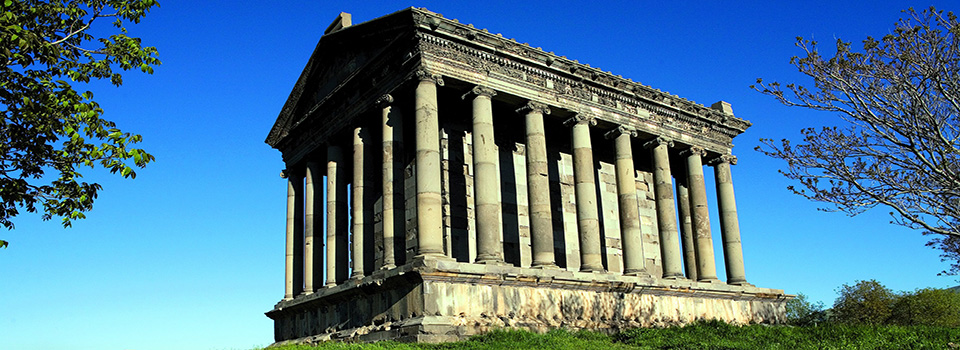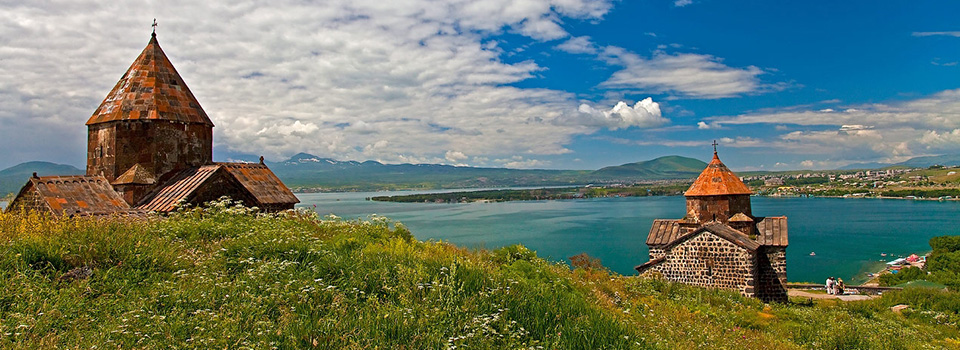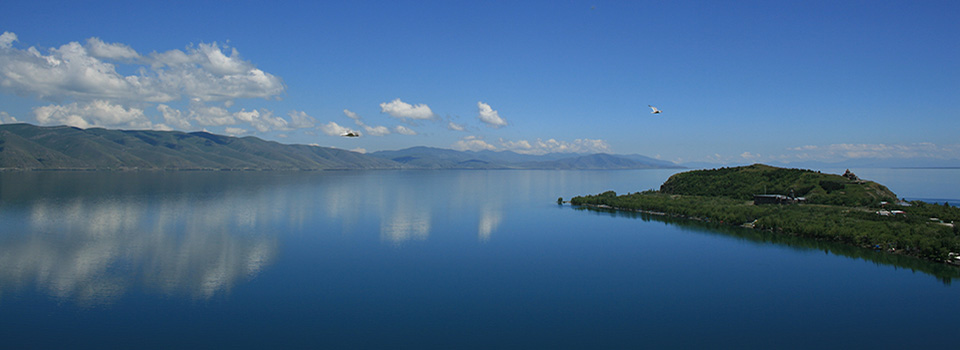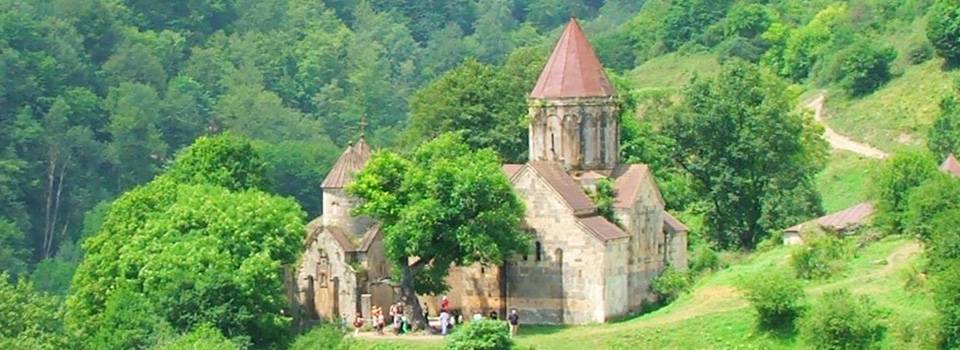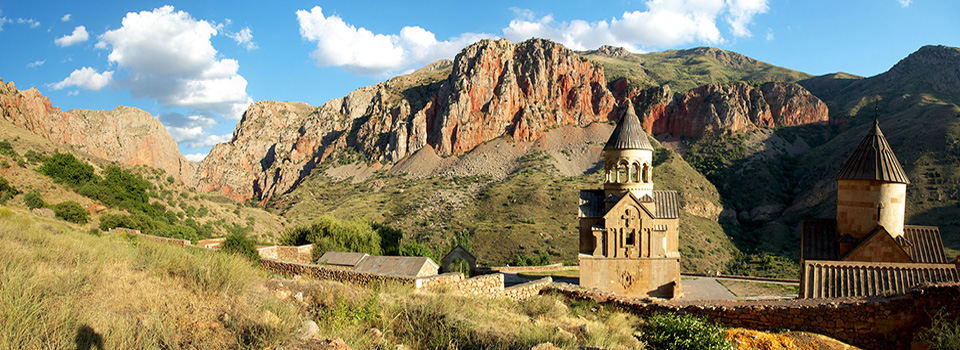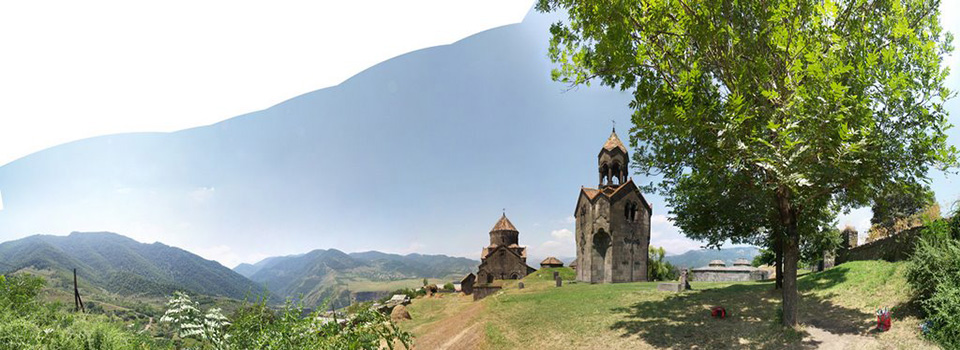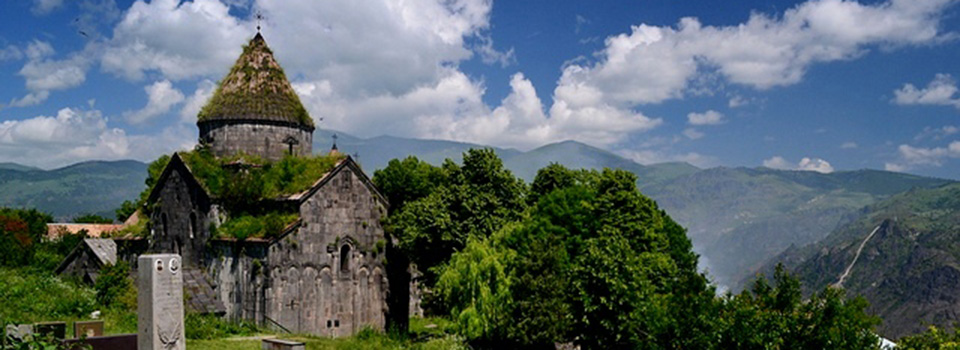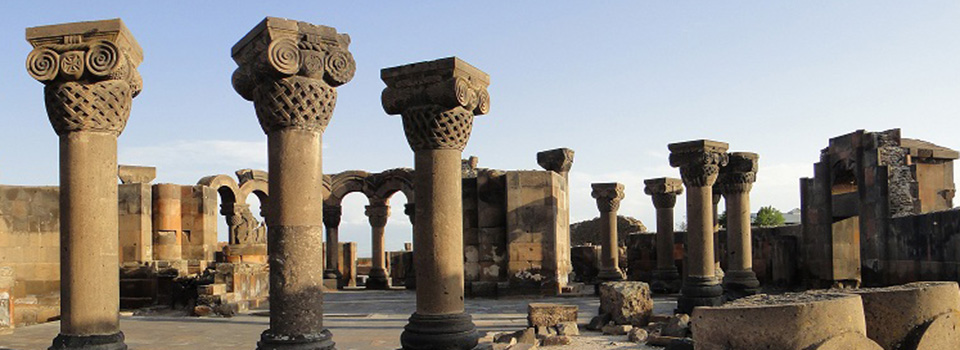Armenia is a country with many unique religious, historical and cultural complexes. Christianity is at the basis of the Armenian culture and statehood: Armenia is particularly rich in Christian monuments. Among them are the Cathedral of Etchmiadzin, the monasteries of Noravank, Geghard, Khor Virap, Goshavank, Sevan, the ruins of the ancient temple of Zvartnots, cemetery with khachkars in Noratus, monasteries of Haghartsin, Saghmosavank,Tatev and many others. There are also monuments of the pre-Christian era: the ruins of the Urartian Erebuni Teishebaini, the ancient Armenian capital of Armavir, Artashat, the pre-Christian temple of Garni and many others. Armenia's rich history has left its unique imprint on each and every corner of a country, which for three thousand years had twelve capitals, many of which are represented in the modern Republic of Armenia.
Echmiadzin - the religious capital of Armenia
Echmiadzin is the religious capital of Armenia, and is located 19 km west of Yerevan: the city was founded in the 4th century BC as a fortress. The Cathedral of Echmiadzin, one of the oldest existing Christian cathedrals in the world. Next to it is the residence of the Catholicos of All Armenians. The temple was founded by the first Catholicos of All Armenians - St. Gregory the Illuminator in 303 AD after he was Jesus Christ himself with a golden hammer, pointing at the place where the Temple of God had to be built. "Etchmiadzin" in Armenian means the Descent of the Only-Begotten. The monastery also includes the Theological Academy built in the 17th - 19th centuries, the Synod, the monastic monks' cells and a library. Theological Academy is a unique institution of the Armenian Apostolic Church, where its future ministers are trained. In the courtyard of the monastery there are beautiful cross stones of various ages, including cross-stone "Saviour” from 1279 and cross-stones the from 17th-century cemetery of Old Jugha, which is now located outside of Armenia. In the Treasury of the Holy Echmiadzin relics and articles of church plate of the Armenian Apostolic Church are found. An important shrine of Echmiadzin is the Holy Lance, which is said to be holding the blood of Jesus Christ himself. It was brought to Armenia by the Holy Apostle Thaddaeus, and was originally kept in the Monastery of Geghardavank. In Echmiadzin stores particles of the Life-Giving Tree and the Sand Cross of Christ , a particle of Noah's Ark, which God sent to the bishop Hakob Mtsbnetsi on the slopes of Mount Ararat in the 4th century, as well as the particle the crown of thorns of the Saviour. In the treasury are also relics of St.John the Baptist, St. Stephen Protomartyr, the Apostles Thaddeus and Bartholomew and Thomas, the great saints of the Christ's Church. The Echmiadzin Church of Holy Hripsime is dedicated to one of thirty-seven Roman women who were tortured to death for their faith. Other martyrs were Gayane and Mariane: temples in their honor were also erected in Echmiadzin. The Cathedral, the Churches of St Hripsime and St. Gayane are registered in the Cultural Heritage Site of UNESCO. In Echmiadzin seminary Komitas, the great genius of Armenian spiritual music.
Temple of Heaven vigil forces Zvartnots
Ruins of Zvartnots temple, 15 km off Yerevan, are unique. In the difficult years of struggle against the invaders, in the 7th century Catholicos Nerses the Third, laid the Temple of Heaven Vigil Forces, dedicated to St. Gregory the Illuminator. The temple became a symbol of unwavering faith in Christian Armenians. The Temple, considered an architectural marvel, served as a prototype for many other Armenian churches, and destroyed by a strong earthquake in about three centuries after its construction. The ruins of Zvartnots Cathedral are also included in the World Heritage List of UNESCO.
Biblical Mount Ararat
Khor Virap monastery
"And the ark stopped in the seventh month, on the seventeenth day of the month ... on the mountains of Ararat" (Genesis 8:4) According to the Bible, it is on Mount Ararat in Armenia that the Noah's Ark stopped. Thus, Ararat is the Holy Mountain, a place of salvation of mankind, a place of pilgrimage for Christians, including Armenians. The history of the Armenian nation is connected with the history of this majestic mountain. This mountain has enormous spiritual energy, it has inspired poets and pilgrims, artists and writers. Mount Ararat is a true symbol of Armenia and the Armenian people, in spite of the fact that today it is in the territory of Turkey. The beautifulest panorama of Mount Ararat is visible from Armenia. Ararat is the highest point of the Armenian highlands.
The best views of Biblical Mount Ararat, however, open from the Monastery of Khor Virap associated with the adoption of Christianity by Armenia in 301. In ancient times in this place was one of the capitals of Armenia - Aratashat. Translated from the Armenian Khor Virap means "deep pit" - the name is no coincidential, since the monastery was built over an underground dungeon, where St. Gregory the Illuminator was languished for 13 years by the order of King Tiridates the Third for the fact that professed Christianity. Filled with poisonous snakes and insects the dungeon did not break the faith of St. Gregory. One of the local pious women brought him food and drink. Meanwhile, King Tiridates went mad, St. Gregory cured him and the king accepted Christianity as the state religion of Armenia. In 642 Catholicos Nerses built a chapel over the dungeon. It was later destroyed. In its place a new chapel was built in the 17th. The dungeon, where St. Gregory was detaine could be visited nowadays: it is 4.4 m in diameter and 6 m in height. In 1662 the Church of Virgin Mary was built.
Noravank Monastery
The Noravank monastery was built in 13th century over the gorge of the Arpa River out of amazing sheer red cliffs. It is truly the treasury of Armenian religious art. Here are the most beautiful cross stones of one of the famous masters - Momik. The most unique is the two-story church Astvatsatsin with a chapel on the second floor connected to the first floor through narrow staircases console. The complex also includes the Priory Church of St. John the Baptist, the chapel of St. Gregory the Illuminator. In the 13th - 14th centuries the Monastery became the seat of the bishops of the province of Syunik, one of the major religious, cultural and educational centers of Armenia.
Tatev Monastery
To reach the Monastery of Tatev - the largest center of religion, culture, science and education of medieval Armenia, one should use the longest cable car in the world. The monastery was founded in the year 839. The monastery was named Tatev, because the architect, who built it asked from the Holy Spirit to give him wings to fly. Today the monastery compound consists of three churches: the Blessed Virgin, the Holy Apostles Peter and Paul, and St. Gregory. The Tatev University, founded by theologist Hovhannes Vorotnetsi in the 14th century, was one of the largest in medieval Armenia. The monastery is situated on a rocky plateau above the picturesque gorge of the dizzying flow of the river Vorotan.
Dilijan
Among the beautiful forests, valleys and gorges Aghstev, Dilijan is located - and the famous mountain climatic resort. Dilijan is known for its mineral waters, is located in the heart of the richest national park in Transcaucasia. Many compare Dilijan with Switzerland: resort ideal climate contributes to the improvement of people with lung diseases. Dilijan is famous for its skilled craftsmen who have learned to skillfully handle the wood - the material, which the Lord has given generously of their homes. The city rebuilt the entire block with an ethnographic museum, designed in the spirit of ethnic traditions - from stone and wood with a distinctive mansard roofs and balconies: here, on the street Sharamberyan the works of local craftsmen carving wood and stone. In the resort area a lot of resorts, hotels and resorts.
Monasteries Haghartsin and Goshavank
Around Dilijan one can visit Goshavank Monastery, built in the 12th century, named in the honor of Mekhitar Gosh, the famous Armenian lawyer who wrote the first "Courtbook". The Monastery had a School adjacent to it. In the forests of Dilijan National Park is Haghartsin Monastery of 10 - 13 centuries. At the Monastery's school Armenian musical notes – khazes were taught. The monastery was fully restored in 2008 – 2011.
Monastery of Sevan and Lake Sevan
Lake Sevan is one of the largest Alpine lakes in the world, located at an altitude of 2000 meters. With a surface area of 1240 square meters Sevan is surrounded by mountain ranges and 28 rivers flow into it. The beauty of Sevan landscapes is as marvelous as that of the cultural monuments, located on its shores. One of them is the Sevan Monastery on the peninsula in the northwestern part of the lake: The monastery was founded in 874 by Princess Maryam, daughter of Ashot I Bagratuni. At present the compound includes the Church of Blessed Virgin and that of the Holy Apostles. Behind the walls of the Monastery in the late 9th century king Ashot the Iron defeated the Arab invaders. The monks fought the battle as well. Today the Monastery includes also a Theological Seminary started by Catholicos Vazgen the First.
Garni
The ancient temple of Garni refers to the first century AD and is a magnificent example of architecture of the Hellenistic period. The temple is surrounded by ruins of a compound of temples, baths and palaces, accompanying the summer residence of Armenian kings from 3rd century BC of the 4th century.
Geghard Monastery
Geghard Monastery is a stunning monument of medieval Armenian architecture: part of it is carved in the rock. The monastery is registered on the World Cultural Heritage List of UNESCO. The monastery was founded in the 4th century by St. Gregory the Illuminator, and at first called Ayrivank - "Cave Monastery". The part of the Monastery that reached our days dates back to the 12th - 13 centuries. Geghard monastery is known as the Monastery of the Seven Churches and Forty Altars. Altogether, the compound presents a treasure of Armenian culture. Acoustics in the church of the monastery surprising - in some places, the sound can be heard up to 40 seconds. The mystery of this unique acoustics have not yet been revealed.
Haghpat and Sanahin monasteries
In the north there are two unique Armenian monastery, registered in theUNESCO List of World Cultural Heritage - Haghpat and Sanahin. Sanahin Monastery was founded in the 10th century and was a major center of education: it had an Academy. The book storage of the Monastery of Sanahin was the largest in medieval Armenia are kept church utensils and unique manuscripts. In the vicinity of the Monastery of the Holy Resurrection Church are 13th century - St. Harutyun is located. The monastery of Haghpat was founded by queen Khosrovanush in the 10th century was one of the most important center of culture. Monk-scholar Hovhannes Sarkavag famous for psalms and sermons lived in the Monastery. The monastery compound comprises three churches built in 1025, 1005, and the 10th century.The latter - the Church Holly Sign is still covered with frescoes. In the 18th century great Armenian poet Sayat Nova lived in the Monastery, where he was buried after his death.
Hovhannavank and Saghmosavank monasteries
Aragatsotn region is located around Mount Aragats: there are many beautiful monasteries, castles and churches. On the river bank Qasakh, which forms a canyon of exceeding beauty the monasteries and Hovhannavank and Saghmosavank are situated. Hovhannavank Monastery, surrounded by partially preserved walls is the oldest building of the Monastery.Thea area once hosted an Early Christian church of the 4th century.
Amberd
At an altitude of 2300 m on the slopes of Mount Aragats is themedieval fortress Amberd with a beautiful church, built in 1026. Like most other fortresses in Armenia, Amberd is built on a promontory hanging over the valleys of the rivers and thus protected on the three sides by a natural barrier.
Gyumri, the city of craftsmen
Gyumri is Armenia's second largest city: it is located 122 km north off Yerevan. The settlements on the territory of Gyumri date back to the Bronze Age: and even once became part of the Russian Empire. In 1837 the city was named in honor of Russian queen Alexandra – Alexandrapole. The city was and continues to be the stronghold of the Russian army. In the 19th century was the largest cultural center of Eastern Armenia. Old Gyumri presents a reserve downtown with buildings of black tuff: in modern Armenia is practically the only remaining old city compound. Gyumri has long been famous for its craftsmen - blacksmiths, sculptors, architects, but also musicians and poets. Downtown Gyumri there are many interesting museums, including Museum of Architecture and Urban Life, the sculptor Merkurov Museum, Art Gallery, National History Museum, the poet Avetik Isahakyan Museum sisters Aslamazyan, the Museum of the famous actor Frunzik Mktrchyan Museum.


